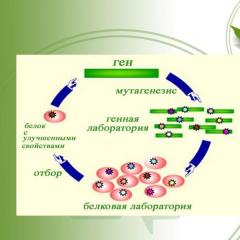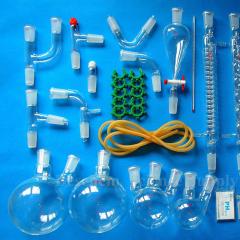Endoplasmic reticulum of the cell. Endoplasmic reticulum. Organelles and other components of the cell. Functions of the granular endoplasmic reticulum
The endoplasmic reticulum (ER), also called the endoplasmic reticulum, is an important eukaryotic cell. It plays a leading role in the production, processing and transport of proteins and lipids. The ER produces transmembrane proteins and lipids for its membrane, as well as for many other cellular components, including secretory vesicles, and plant cells.
The endoplasmic reticulum is a network of tubules and flattened sacs that perform many functions in and. There are two parts of the EPR, which differ in both structure and function. One part is called the granular (rough) ER because it has ribosomes attached to the cytoplasmic side of the membrane. The other part is called the agranular (smooth) ER because it lacks attached ribosomes.
Typically, the smooth ER is a conduit network, while the rough ER consists of a series of flattened sacs. The space inside the ER is called the lumen. The endoplasmic reticulum extends widely from the cell membrane through and forms a continuous connection with the nuclear envelope. Since the ER is connected to the nuclear envelope, the lumen and the space within the nuclear envelope are part of the same compartment.
Granular endoplasmic reticulum
The granular (rough) endoplasmic reticulum produces membranes and secretory proteins. Ribosomes attached to the granular ER synthesize proteins during translation. In some leukocytes (white blood cells), the rough ER produces antibodies. It produces insulin in pancreatic cells.
The granular and agranular ER are typically interconnected, and proteins and membranes produced by the rough ER are translocated into the smooth ER. Some proteins are sent to the Golgi apparatus by special transport vesicles. Once proteins have been modified in the Golgi, they are transported to their proper destinations within or exported from the cell by .
Agranular endoplasmic reticulum
The agranular (smooth) endoplasmic reticulum has a wide range of functions, including the synthesis of carbohydrates and lipids. Lipids such as phospholipids and cholesterol are necessary to create cell membranes. The smooth ER also serves as a transition region for vesicles that transport endoplasmic reticulum products to various destinations.
In liver cells, the agranular ER produces enzymes that help detoxify certain compounds. In muscles, it helps in the contraction of muscle cells, and in brain cells it synthesizes male and female hormones.
Animals and humans. The functions of this component of the cell are varied and are mainly associated with synthesis, modification and transport
The endoplasmic reticulum was first discovered in 1945. The American scientist K. Porter saw it using one of the first electric microscopes. From that time on, its active research began.
There are two types of this organelle in the cell:
- Granular or rough endoplasmic reticulum (covered with many ribosomes).
- Agranular or smooth endoplasmic reticulum.
Each type of reticulum has some characteristics and performs completely different functions. Let's look at them in more detail.
Granular endoplasmic reticulum: structure. This organelle is a system of cisterns, vesicles and tubules. Its walls consist of a bilipid membrane. The width of the cavity can vary from 20 nm to several micrometers - everything depends on the secretory activity of the cell.
In few specialized cells, which are characterized by a low level of metabolism, the EPS is represented by only a few scattered cisterns. Inside a cell that actively synthesizes protein, the endoplasmic reticulum consists of many cisterns and a branched system of tubules.
As a rule, granular ER is connected through tubules to the membranes of the nuclear envelope - this is how complex processes of synthesis and transport of protein molecules occur.
Granular endoplasmic reticulum: functions. As already mentioned, the entire surface of the ER on the cytoplasmic side is covered with ribosomes, which are known to be involved in the ER - this is the site of the synthesis and transport of protein compounds.
This organelle is responsible for the synthesis of the cytoplasmic membrane. But in most cases, the created protein molecules are then transported using membrane vesicles to where they are further modified and distributed according to the needs of the cell and tissues.
In addition, some protein changes occur in the cavities of the EPS tanks - for example, the addition of a carbohydrate component to it. Here, large secretory granules are formed by aggregation.
Agranular endoplasmic reticulum: structure and functions. The structure of smooth EPS has some differences. For example, such an organelle consists only of cisterns and does not have a system of tubules. Complexes of such EPS, as a rule, are smaller in size, but the width of the tank, on the contrary, is larger.
The smooth endoplasmic reticulum is not related to the synthesis of protein components, but performs a number of equally important functions. For example, this is where the synthesis of steroid hormones occurs in humans and all vertebrates. That is why the volume of smooth ER in adrenal cells is quite large.
In liver cells, EPS produces the necessary enzymes that are involved in carbohydrate metabolism, namely in the breakdown of glycogen. It is also known that liver cells are responsible for neutralizing toxins. In the tanks of this organelle, a hydrophilic component is synthesized, which then attaches to the toxic molecule, increasing its solubility in the blood and urine. It is interesting that in hepatocytes, which are constantly susceptible to the influence of toxins (poisons, alcohol), almost the entire cell is occupied by densely located tanks of smooth ER.
Muscle cells contain a special type of smooth ER - the sarcoplasmic reticulum. It acts as a calcium depot, thus regulating the processes of cell activity and rest.
As you can see, the functions of the EPS are diverse and very important for the normal functioning of a healthy cell.
Endoplasmic reticulum (ER) , or endoplasmic reticulum (ER), is a system consisting of membrane cisterns, channels and vesicles. About half of all cell membranes are located in the ER.
Morphofunctionally, the EPS is differentiated into 3 sections: rough (granular), smooth (agranular) and intermediate. The granular ER contains ribosomes (PC), while the smooth and intermediate ER lack them. The granular ER is mainly represented by cisterns, while the smooth and intermediate ER is mainly represented by channels. The membranes of tanks, channels and bubbles can pass into each other. ER contains a semi-liquid matrix characterized by a special chemical composition.
ER functions:
- compartmentalization;
- synthetic;
- transport;
- detoxification;
- regulation of calcium ion concentration.
Compartmentalization function
associated with the division of cells into compartments (compartments) using ER membranes. Such division makes it possible to isolate part of the contents of the cytoplasm from the hyaloplasm and allows the cell to isolate and localize certain processes, as well as make them occur more efficiently and in a directed manner.
Synthetic function.
Almost all lipids are synthesized on the smooth ER, with the exception of two mitochondrial lipids, the synthesis of which occurs in the mitochondria themselves. Cholesterol is synthesized on the membranes of the smooth ER (in humans, up to 1 g per day, mainly in the liver; with liver damage, the amount of cholesterol in the blood drops, the shape and function of red blood cells change, and anemia develops).
Protein synthesis occurs on the rough ER:
- internal phase of the ER, Golgi complex, lysosomes, mitochondria;
- secretory proteins, for example hormones, immunoglobulins;
- membrane proteins.
Protein synthesis begins on free ribosomes in the cytosol. After chemical transformations, proteins are packaged into membrane vesicles, which are detached from the ER and transported to other areas of the cell, for example, to the Golgi complex.
Proteins synthesized in the ER can be divided into two streams:
- internal ones, which remain in the ER;
- external ones that do not remain in the ER.
Internal proteins, in turn, can also be divided into two streams:
- residents who do not leave the Republic of Estonia;
- transit, leaving the Republic of Estonia.
Happens in the ER detoxification of harmful substances
that have entered the cell or formed in the cell itself. Most harmful substances are
hydrophobic substances, which therefore cannot be excreted from the body in urine. The ER membranes contain a protein called cytochrome P450, which converts hydrophobic substances into hydrophilic ones, and after that they are removed from the body in the urine.
Structure of the endoplasmic reticulum
Definition 1
Endoplasmic reticulum(ER, endoplasmic reticulum) is a complex ultramicroscopic, highly branched, interconnected system of membranes that more or less evenly penetrates the mass of the cytoplasm of all eukaryotic cells.
EPS is a membrane organelle consisting of flat membrane sacs - cisterns, channels and tubes. Thanks to this structure, the endoplasmic reticulum significantly increases the area of the internal surface of the cell and divides the cell into sections. It's filled inside matrix(moderately dense loose material (synthesis product)). The content of various chemical substances in the sections is not the same, therefore, various chemical reactions can occur in a cell, both simultaneously and in a certain sequence, in a small volume of the cell. The endoplasmic reticulum opens in perinuclear space(the cavity between two caryolem membranes).
The membrane of the endoplasmic reticulum consists of proteins and lipids (mainly phospholipids), as well as enzymes: adenosine triphosphatase and enzymes for the synthesis of membrane lipids.
There are two types of endoplasmic reticulum:
- Smooth (agranular, aES), represented by tubes that anastomose with each other and do not have ribosomes on the surface;
- Rough (granular, grES), also consisting of interconnected cisterns, but they are covered with ribosomes.
Note 1
Sometimes they also allocate passing or transient(tES) endoplasmic reticulum, which is located in the area of transition of one type of ES to another.
Granular ES is characteristic of all cells (except sperm), but the degree of its development varies and depends on the specialization of the cell.
GRES of epithelial glandular cells (pancreas, producing digestive enzymes, liver, synthesizing serum albumin), fibroblasts (connective tissue cells producing collagen protein), plasma cells (producing immunoglobulins) is highly developed.
Agranular ES predominates in adrenal cells (synthesis of steroid hormones), in muscle cells (calcium metabolism), in the cells of the fundic glands of the stomach (release of chlorine ions).
Another type of EPS membranes are branched membrane tubes containing a large number of specific enzymes inside, and vesicles - small vesicles surrounded by a membrane, mainly located next to the tubes and cisterns. They ensure the transfer of those substances that are synthesized.
EPS functions
The endoplasmic reticulum is an apparatus for the synthesis and, partly, transport of cytoplasmic substances, thanks to which the cell performs complex functions.
Note 2
The functions of both types of EPS are associated with the synthesis and transport of substances. The endoplasmic reticulum is a universal transport system.
The smooth and rough endoplasmic reticulum with its membranes and contents (matrix) perform common functions:
- separation (structuring), due to which the cytoplasm is distributed in an orderly manner and does not mix, and also prevents random substances from entering the organelle;
- transmembrane transport, due to which necessary substances are transferred through the membrane wall;
- synthesis of membrane lipids with the participation of enzymes contained in the membrane itself and ensuring the reproduction of the endoplasmic reticulum;
- Due to the potential difference that arises between the two surfaces of the ES membranes, it is possible to ensure the conduction of excitation impulses.
In addition, each type of network has its own specific functions.
Functions of smooth (agranular) endoplasmic reticulum
The agranular endoplasmic reticulum, in addition to the named functions common to both types of ES, also performs functions unique to it:
- calcium depot. In many cells (in skeletal muscles, in the heart, eggs, neurons) there are mechanisms that can change the concentration of calcium ions. Striated muscle tissue contains a specialized endoplasmic reticulum called the sarcoplasmic reticulum. This is a reservoir of calcium ions, and the membranes of this network contain powerful calcium pumps that can release large amounts of calcium into the cytoplasm or transport it into the cavities of the network channels in hundredths of a second;
- lipid synthesis, substances such as cholesterol and steroid hormones. Steroid hormones are synthesized mainly in the endocrine cells of the gonads and adrenal glands, in the cells of the kidneys and liver. Intestinal cells synthesize lipids, which are excreted into the lymph and then into the blood;
detoxification function– neutralization of exogenous and endogenous toxins;
Example 1
Kidney cells (hepatocytes) contain oxidase enzymes that can destroy phenobarbital.
organelle enzymes take part in glycogen synthesis(in liver cells).
Functions of the rough (granular) endoplasmic reticulum
In addition to the listed general functions, the granular endoplasmic reticulum is also characterized by special ones:
- protein synthesis at the State Power Plant has some peculiarities. It begins on free polysomes, which subsequently bind to ES membranes.
- The granular endoplasmic reticulum synthesizes: all proteins of the cell membrane (except for some hydrophobic proteins, proteins of the internal membranes of mitochondria and chloroplasts), specific proteins of the internal phase of membrane organelles, as well as secretory proteins that are transported throughout the cell and enter the extracellular space.
- post-translational modification of proteins: hydroxylation, sulfation, phosphorylation. An important process is glycosylation, which occurs under the action of the membrane-bound enzyme glycosyltransferase. Glycosylation occurs before the secretion or transport of substances to certain parts of the cell (Golgi complex, lysosomes or plasmalemma).
- transport of substances along the intramembrane part of the network. Synthesized proteins move through the gaps of the ES to the Golgi complex, which removes substances from the cell.
- due to the participation of the granular endoplasmic reticulum The Golgi complex is formed.
The functions of the granular endoplasmic reticulum are associated with the transport of proteins that are synthesized in ribosomes and located on its surface. Synthesized proteins enter the EPS, fold and acquire a tertiary structure.
The protein that is transported to the cisterns changes significantly along the way. It can, for example, be phosphorylated or converted into a glycoprotein. The usual route for a protein is through the granular ER into the Golgi apparatus, from where it either exits the cell, goes to other organelles of the same cell, such as lysosomes), or is deposited as storage granules.
In liver cells, both granular and non-granular endoplasmic reticulum take part in the processes of detoxification of toxic substances, which are then removed from the cell.
Like the outer plasma membrane, the endoplasmic reticulum has selective permeability, as a result of which the concentration of substances inside and outside the reticulum channels is not the same. This has implications for cell function.
Example 2
There are more calcium ions in the endoplasmic reticulum of muscle cells than in its cytoplasm. Leaving the channels of the endoplasmic reticulum, calcium ions trigger the process of contraction of muscle fibers.
Formation of the endoplasmic reticulum
The lipid components of the endoplasmic reticulum membranes are synthesized by enzymes of the reticulum itself, while the protein components come from ribosomes located on its membranes. The smooth (agranular) endoplasmic reticulum does not have its own protein synthesis factors, therefore it is believed that this organelle is formed as a result of the loss of ribosomes by the granular endoplasmic reticulum.



